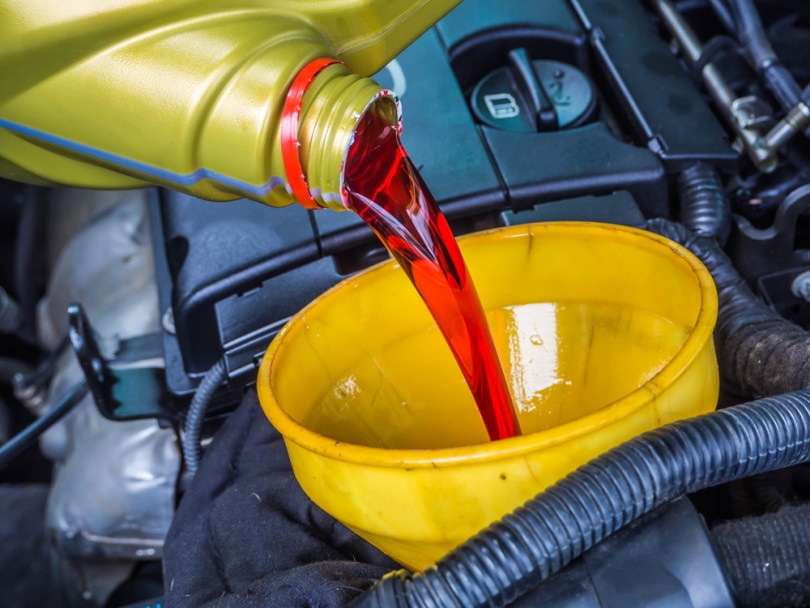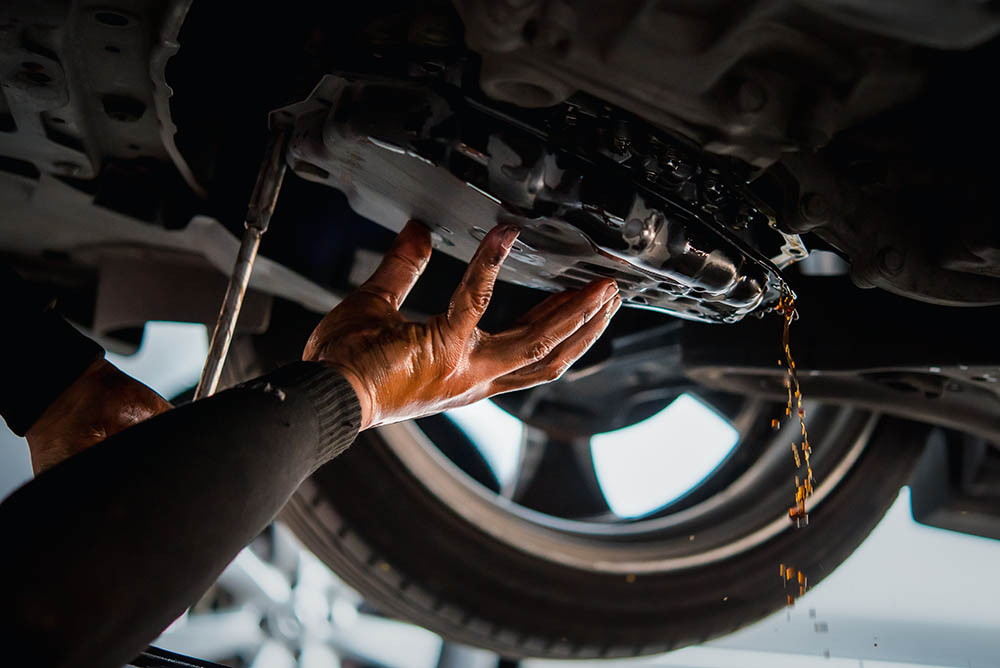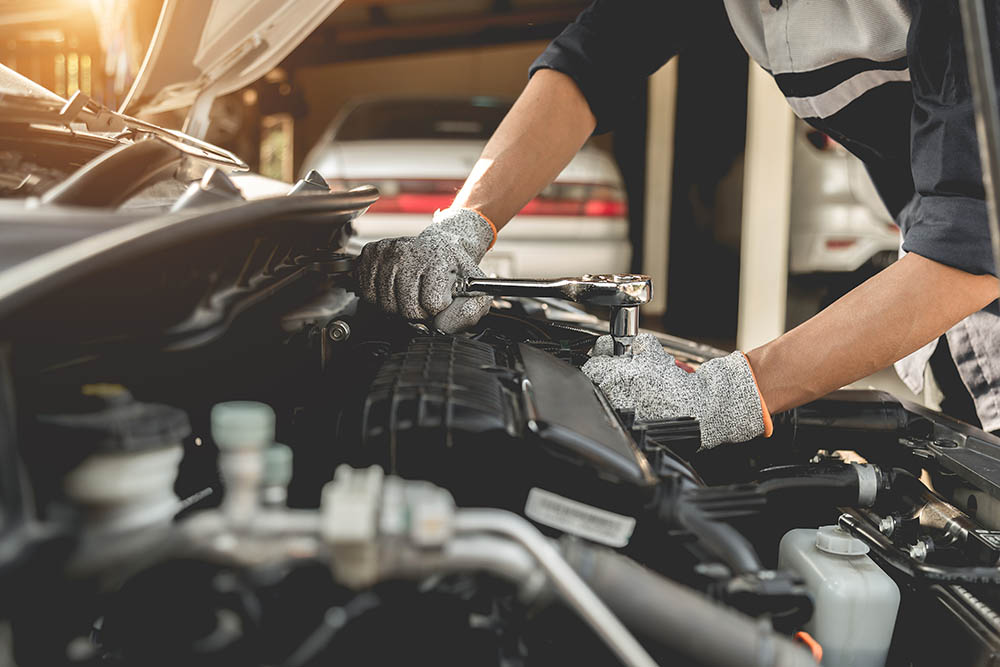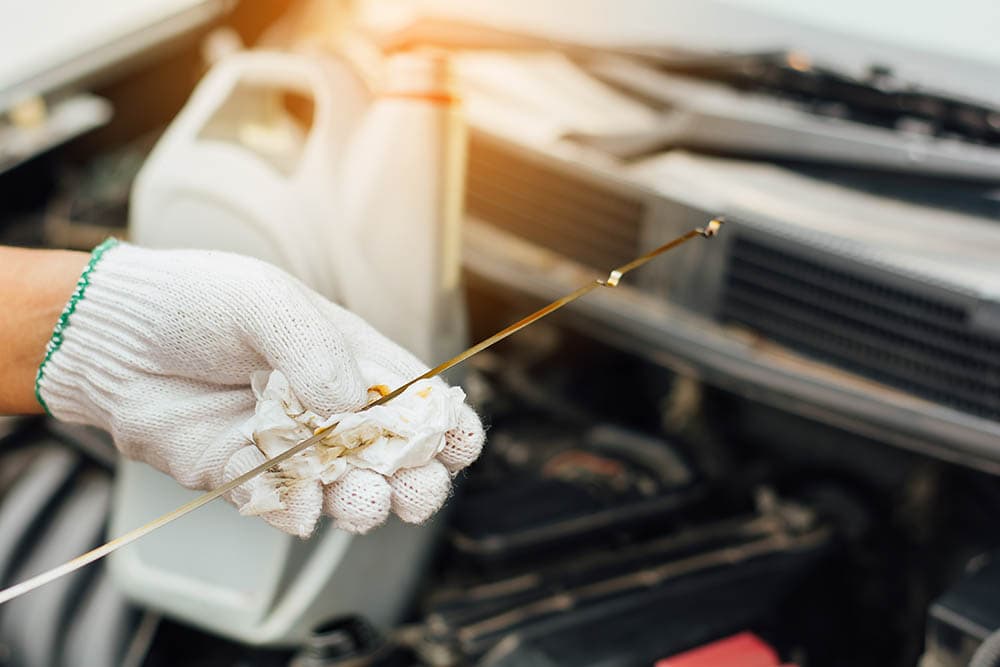Why Does My Transmission Fluid Leak When Parked? Signs, Reasons, & Fixes
-
- Last updated:

It isn’t always cause for concern when you see an occasional liquid drip under your car after parking. But the telltale red stain of a transmission fluid leak is one situation that you shouldn’t shrug off.
There are many reasons why transmission fluid leaks when your car is parked, including a damaged transmission pan, a cracked torque converter, or a worn O-ring. If your vehicle is leaking transmission fluid, it’s crucial to identify the problem and fix it before it leads to severe failure and expensive repairs.
To help you avoid the cost and frustration of a busted transmission, we’ll explain how to identify transmission fluid and discuss some of the reasons why your car leaks.

Identifying Transmission Fluid
The transmission typically sits centered between the tires, running from the engine to the middle of the car. When it leaks, you’ll find a puddle of fluid under that area of your vehicle.
To confirm it is transmission fluid, place a large pan, towel, or newspaper to catch some drops. Fresh transmission fluid is pink or red, making it easier to identify, but it turns brown or even black with age as it becomes dirty.
Since the transmission fluid acts as a lubricant for the various moving parts, it has an oily texture. It’s slightly thinner than motor oil and along with its red color and slick feel, you may also notice a petroleum-like odor. If the fluid is old, it may even smell burnt.
If you think your car is leaking transmission fluid, check the levels with the dipstick under the hood to see if your fluid levels are low. Follow your vehicle instructions for specific steps on accurately checking the fluid levels.

What Are the Symptoms of a Transmission Fluid Leak?
Even if you don’t notice the leak under your car, you’ll eventually feel its effects on your car’s performance. Low transmission fluid will cause several problems as you drive, such as gears grinding or slipping.
You will experience issues when hydraulic pressure isn’t high enough to properly shift or hold a gear, causing sluggish and delayed shifting, slow acceleration, high RPMs, and some noticeable vibrations and clunks as your transmission struggles to move the car. And when your transmission fluid levels are dry, your car will not shift into gear at any point.
Other possible symptoms of a transmission fluid leak include:
- Overheating transmission
- The “Check engine” light comes on
- Trouble shifting
- Foul burning smell
When these issues arise, it’s crucial to take your car to a service center as soon as possible. Continuing to drive will only worsen the problem, intensifying the leak and eventually causing seals, gears, and casings to overheat and break.

Where Is Transmission Fluid Leaking?
After confirming that it’s a transmission fluid leak, it’s time to locate the source of the leak, which isn’t always an easy task. There are dozens of connections, reservoirs, and seals where a leak could open, along with several paths it can follow before it finally drops to the ground.
It can take some time to pinpoint the source. There are tricks for locating transmission fluid leaks, such as applying baby powder, but you can also check common trouble points within the transmission system.
Damaged or Worn Pan
A poorly installed or damaged transmission pan on the underside of your vehicle is often the culprit when you’re dealing with a leak. Fortunately, it’s also a simple repair in many cases.
The transmission pan sits under the transmission to hold about half the transmission fluid, with a gasket sealing it off from leaks. Road debris, dirt, moisture, extreme heat, and several other factors can degrade the gasket or the pan over time. Rocks may open holes in the pan, bolts could come loose, the pan might become dented or warped, or the gasket could dry and crack.
There are countless ways it can fail. But if you determine the leak is coming from the transmission pan, you may only need to replace the pan or the gasket, which is a relatively cheap DIY project.
Unfortunately, gravity draws transmission fluid down. Since the flow terminates at the pan, you can’t get too excited thinking that you’ve found the source just because there’s a ton of fluid around the gasket! You’ll need to feel past the pan to search for leaking fluid. At a certain point, if you haven’t pinpointed the source, you’ll likely have to take it to a mechanic as soon as possible.

Bad Seal
Several seals throughout the transmission case keep transmission fluid in place. The most critical seals, and the ones most prone to wear that leads to leaks, are the input and output shaft seals. These seals sit where the torque converter connects to the transmission (input) and the transmission connects to the wheels (output).
As the seals face heat and motion, they can warp or degrade and eventually open up a leak. But among the many sensors, hoses, and other connections that run to the transmission body, numerous seals could potentially wear down.
Leak from Torque Converter
The torque converter sits between the engine and the transmission. It’s a donut-shaped coupling that transfers power from the engine and allows the car to stop with the engine running.
Transmission fluid lubricates moving parts in the torque converter and acts as the hydraulic fluid that propels the turbine and thus the input shaft. A leak can open up when the torque converter suffers damage, such as a broken seal or cracked needle bearing.

Broken Fluid Lines
Fluid lines running between the various transmission parts can crack and crumble under stress and eventually leak. For instance, if you find a transmission leak toward the front of the vehicle when it’s parked, it could be an issue with a transmission fluid line running to the radiator. Transmission fluid flows to the radiator to cool down, and it’s not uncommon for these lines and connections to loosen and break over time.
Why Does My Transmission Fluid Leak When Parked?
Along with damage, poor maintenance practices could cause a transmission fluid leak. If you don’t regularly check or change your fluids and service your vehicle, contaminants and low levels can cause clogs and excess friction. These lead to the internal gear and seal breakdowns that create leaks.
Preventing Transmission Fluid Leaks
Every time a gear slips or the transmission overheats, the components take a hit, wearing them out and creating the kinds of gaps that make a leak even worse. Preventing transmission fluid problems is critical to avoid those issues and extend the transmission’s life. It starts with frequent checks and scheduled service.
Check your transmission fluid dipstick regularly, following the instructions for your particular model. It often requires you to check the fluid levels while the engine is warm and running. Pull out the dipstick, wipe any fluid off of it, reinsert it, and pull it out again. If the fluid isn’t in the indicated “safe” area, it needs a refill.
- Related read: 10 Best Transmission Additives – Reviews & Top Picks

If you need to add more transmission fluid, check the vehicle guidelines to find the appropriate product. It’s also crucial to schedule regular transmission flushing and replacement, often around the 30,000-mile mark. As transmission fluid ages and picks up contaminants from the various moving parts, it turns brown, burns out, and loses performance. Refreshing the fluid will keep the transmission components clean, lubricated, and functioning correctly.

Final Thoughts
If you aren’t experiencing any mechanical issues with your car yet, a transmission fluid leak shouldn’t stress you out, but it should spur some action. Follow these tips to identify transmission fluid and locate the leak so you can take the next steps to repair the problem. By fixing the problem fast and maintaining your transmission fluid levels, you can easily avoid expensive malfunctions in the future.
Featured Image Credit: Setta Sornnoi, Shutterstock
Contents

